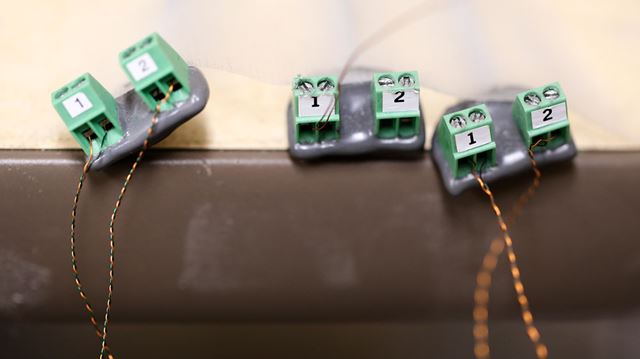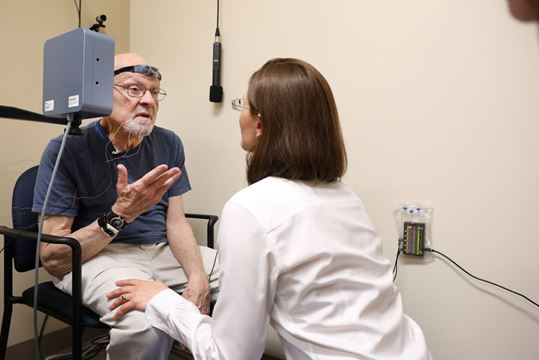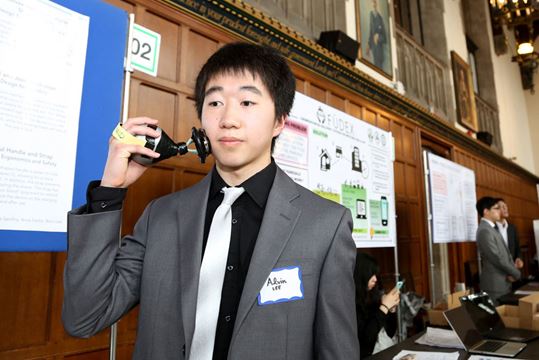These Assistive Technology Advances Will Transform Lives
als assistive tech Assistive Technology mnd
By definition, technology is the application of science to make human lives better and easier. We often get lost in the latest smartphones and gadgets, but some of the most important advances are those that target those of us most in need of help – the elderly and disabled. Researchers are doing amazing things on the cutting edge of assistive technology. Let’s take a look at some examples that you or a loved one could make use of one day.
Sponsored by the Defense Advanced Research Projects Agency (DARPA), the same organization that funded the Big Dog robot, the DEKA Arm is a robotic arm designed to restore functionality to individuals who have undergone upper arm amputations. By all accounts, it has revolutionized prosthetics — giving the user greater range of motion and control options than any other solution.
The DEKA arm is still slow and clumsy compared to an organic limb, but it’s still a huge improvement over no limb at all – and the technology is improving quickly.
Grid Pad by Smartbox is a communication aid that generates high-quality speech output for those with difficulty communicating. Depending on which model you choose, it can be controlled by touch or a very accurate eye gaze system. Users can carry it around as a mobile device or mount it on a wheelchair for easy access. Devices like the Grid Pad have the potential to change lives by breaking down a major social barrier, allowing people to communicate more effectively than ever before.
Imagine what it must feel like for the visually impaired to try to use a smartphone. This is a major aspect of modern life, which is almost entirely cut off to them. While most of today’s devices offer accessibility features that make some use possible, the reality is that the results are inconvenient at best. That’s why India-based startup Kriyate is working on a Braille-enabled smartphone that allows blind users to enjoy a fully touch-based experience. The device features a grid of pins that move up and down, allowing the user to touch and read messages and other information. It is expected to sell for about $184.
If you have a disability that inhibits the use of your legs, getting around can be difficult — particularly if you need to drive somewhere. Sure, there are car modifications available, but they’re just that — modifications on vehicles designed for the non-disabled. Wouldn’t it be better to drive a car that was built from the ground up for people in wheelchairs? That’s where Kenguru comes in. It’s an electric car capable of driving up to 25 mph and up to 45 miles on a single charge, designed specifically for paraplegics. The Kenguru car allows people to be more independent and spontaneous — two traits often lost in the wake of a disability.
People with epilepsy can have seizures at any moment, often without warning. This can create a dangerous situation if they’re not prepared, particularly for epileptic children. A group of Rice University engineers has developed a wearable device that detects seizures and calls for help. Known as the SMART (Seizure Monitoring and Response Transducer) belt, it detects changes in skin conductance and monitors breathing to determine when a seizure is taking place. The device can then wirelessly notify a parent or caregiver to take action.
We already know that driverless cars are on track to change transportation forever, but one implication that isn’t often discussed is the potential for the blind or otherwise disabled to regain some of their independence. Once self-driving cars have become commonplace, the visually impaired and the infirm will be able to leave their homes at a moment’s notice without depending on anyone else to pick them up.
The video above shows Steve Mahan, who suffers from 95 percent vision loss, taking a ride in one of Google’s autonomous cars. “You lose your timing in life; everything takes you much longer,” he said. “There are some places that you cannot go; there are some things that you really cannot do. Where this would change my life is to give me the independence and the flexibility to go the places I both want to go and need to go, when I need to do those things.”
When Israeli engineer Amit Goffer suffered a terrible accident that left him confined to a wheelchair, he never stopped dreaming of the day technology would allow him to walk again. In 2001, he founded ReWalk, a company that aims to help people with spinal cord injuries regain their mobility. Now, with approval from the FDA, ReWalk’s bionic exoskeleton is helping paraplegics stand and walk normally — an achievement they could only dream of just a few years ago.
These technologies can dramatically change the lives of some of the most vulnerable people in our world. They’re incredibly important – and advancing rapidly. It’s an incredibly exciting time, and anything is possible.
Have you or a loved one used any of these technologies? Did we miss anything that should have made the list? Let us know in the comments below!
The DEKA Arm
Sponsored by the Defense Advanced Research Projects Agency (DARPA), the same organization that funded the Big Dog robot, the DEKA Arm is a robotic arm designed to restore functionality to individuals who have undergone upper arm amputations. By all accounts, it has revolutionized prosthetics — giving the user greater range of motion and control options than any other solution.
The DEKA arm is still slow and clumsy compared to an organic limb, but it’s still a huge improvement over no limb at all – and the technology is improving quickly.
Grid Pad Communication Aid
Grid Pad by Smartbox is a communication aid that generates high-quality speech output for those with difficulty communicating. Depending on which model you choose, it can be controlled by touch or a very accurate eye gaze system. Users can carry it around as a mobile device or mount it on a wheelchair for easy access. Devices like the Grid Pad have the potential to change lives by breaking down a major social barrier, allowing people to communicate more effectively than ever before.
The World’s First Braille Smartphone
Imagine what it must feel like for the visually impaired to try to use a smartphone. This is a major aspect of modern life, which is almost entirely cut off to them. While most of today’s devices offer accessibility features that make some use possible, the reality is that the results are inconvenient at best. That’s why India-based startup Kriyate is working on a Braille-enabled smartphone that allows blind users to enjoy a fully touch-based experience. The device features a grid of pins that move up and down, allowing the user to touch and read messages and other information. It is expected to sell for about $184.
The Kenguru Car
If you have a disability that inhibits the use of your legs, getting around can be difficult — particularly if you need to drive somewhere. Sure, there are car modifications available, but they’re just that — modifications on vehicles designed for the non-disabled. Wouldn’t it be better to drive a car that was built from the ground up for people in wheelchairs? That’s where Kenguru comes in. It’s an electric car capable of driving up to 25 mph and up to 45 miles on a single charge, designed specifically for paraplegics. The Kenguru car allows people to be more independent and spontaneous — two traits often lost in the wake of a disability.
SMART Belt
People with epilepsy can have seizures at any moment, often without warning. This can create a dangerous situation if they’re not prepared, particularly for epileptic children. A group of Rice University engineers has developed a wearable device that detects seizures and calls for help. Known as the SMART (Seizure Monitoring and Response Transducer) belt, it detects changes in skin conductance and monitors breathing to determine when a seizure is taking place. The device can then wirelessly notify a parent or caregiver to take action.
Self-Driving Cars
We already know that driverless cars are on track to change transportation forever, but one implication that isn’t often discussed is the potential for the blind or otherwise disabled to regain some of their independence. Once self-driving cars have become commonplace, the visually impaired and the infirm will be able to leave their homes at a moment’s notice without depending on anyone else to pick them up.
The video above shows Steve Mahan, who suffers from 95 percent vision loss, taking a ride in one of Google’s autonomous cars. “You lose your timing in life; everything takes you much longer,” he said. “There are some places that you cannot go; there are some things that you really cannot do. Where this would change my life is to give me the independence and the flexibility to go the places I both want to go and need to go, when I need to do those things.”
ReWalk Exoskeleton
When Israeli engineer Amit Goffer suffered a terrible accident that left him confined to a wheelchair, he never stopped dreaming of the day technology would allow him to walk again. In 2001, he founded ReWalk, a company that aims to help people with spinal cord injuries regain their mobility. Now, with approval from the FDA, ReWalk’s bionic exoskeleton is helping paraplegics stand and walk normally — an achievement they could only dream of just a few years ago.
These technologies can dramatically change the lives of some of the most vulnerable people in our world. They’re incredibly important – and advancing rapidly. It’s an incredibly exciting time, and anything is possible.
Have you or a loved one used any of these technologies? Did we miss anything that should have made the list? Let us know in the comments below!

















